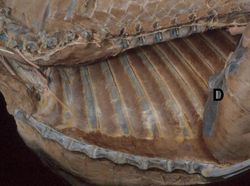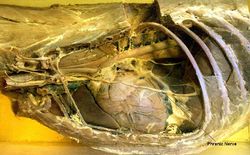Difference between revisions of "Diaphragm - Anatomy & Physiology"
Fiorecastro (talk | contribs) |
|||
| (6 intermediate revisions by 2 users not shown) | |||
| Line 1: | Line 1: | ||
| − | + | [[Image:DogThorax.jpg|right|thumb|250px|''Dog Thorax, contents of Thoracic Cavity removed. ©Nottingham 2008'']] | |
| − | [[Image:DogThorax.jpg|right|thumb|250px|''Dog Thorax, contents of Thoracic Cavity removed. | + | |
==Introduction== | ==Introduction== | ||
| − | The Diaphragm is a dome-shaped musculotendinous sheet separating the thoracic and abdominal cavities. It is convex on | + | The Diaphragm is a dome-shaped musculotendinous sheet separating the thoracic and abdominal cavities. It is convex on it's cranial surface. In the neutral position between full [[Anatomy and Physiology#Inspiration|inspiration]] and full [[Anatomy and Physiology#Expiration|expiration]], the most cranial part of the Diaphragm is in line with the 6th Rib. |
==Structure== | ==Structure== | ||
| − | The | + | The Muscular part of the diaphragm is peripheral, surrounding the central Tendinous area. The muscular part has sections which arise from the xiphoid Process of the [[Ribs and Sternum - Anatomy & Physiology|Sternum]], [[Spinal Column - Anatomy & Physiology|vertebral Column]] and caudal [[Ribs and Sternum - Anatomy & Physiology|ribs]]. |
==Openings within the diaphragm== | ==Openings within the diaphragm== | ||
| − | The | + | The Diaphragm has three openings: '''Aortic Hiatus''' - the most Dorsal opening, contains the Aorta, Azygous Vein and Thoracic Duct; '''Oesophageal Hiatus''' - contains the oesophagus, dorsal and ventral Vagal trunks and '''Caval Foramen''' - lies within the central tendoninous region of the diaphragm, and contains the Caudal Vena Cava. This opening does not allow movement;the diaphragm is fused with the vessel wall. |
| − | :'''Aortic Hiatus''' - the most | ||
| − | |||
| − | |||
==Function== | ==Function== | ||
| − | During [[Anatomy and Physiology#Inspiration| | + | During [[Anatomy and Physiology#Inspiration|Inspiration]], the diaphragm contracts to increase the volume of the thoracic cavity, decreasing it's pressure, thus drawing air in. The Diaphragm relaxes for [[Anatomy and Physiology#Expiration|Expiration]]. |
==Innervation== | ==Innervation== | ||
[[Image:PhrenicNerveDog.jpg|right|thumb|250px|©RVC 2008]] | [[Image:PhrenicNerveDog.jpg|right|thumb|250px|©RVC 2008]] | ||
| − | The | + | The Diaphragm is supplied by the '''phrenic nerve'''. |
==Species differences== | ==Species differences== | ||
| − | Because of the shorter thorax, the diaphragm is steeper in the '''ruminant''' compared to the '''horse'''. '''Avian''' species do not possess a diaphragm. Air moves in and out of their lungs via [[Avian Respiration - Anatomy & Physiology#Air Sacs| | + | Because of the shorter thorax, the diaphragm is steeper in the '''ruminant''' compared to the '''horse'''. '''Avian''' species do not possess a diaphragm. Air moves in and out of their lungs via [[Avian Respiration - Anatomy & Physiology#Air Sacs|Air Sacs]]. |
| − | |||
| − | |||
| − | |||
| − | |||
==References== | ==References== | ||
| Line 37: | Line 30: | ||
{{citation|initiallast = Dyce|initialfirst = K.M|2last = Sack|2first = W.O|finallast = Wensing|finalfirst = C.J.G|year = 2002|title = Textbook of Veterinary Anatomy|ed =3rd|city = Philadelphia|pub = Saunders}} | {{citation|initiallast = Dyce|initialfirst = K.M|2last = Sack|2first = W.O|finallast = Wensing|finalfirst = C.J.G|year = 2002|title = Textbook of Veterinary Anatomy|ed =3rd|city = Philadelphia|pub = Saunders}} | ||
| − | + | [[Category:Musculoskeletal System]][[Category:Respiratory System - Anatomy & Physiology]] | |
| − | + | [[Category:To Do - AimeeHicks]][[Category:To Do - Review]] | |
| − | |||
| − | [[Category:Musculoskeletal System | ||
| − | [[Category: | ||
Revision as of 13:44, 15 September 2010
Introduction
The Diaphragm is a dome-shaped musculotendinous sheet separating the thoracic and abdominal cavities. It is convex on it's cranial surface. In the neutral position between full inspiration and full expiration, the most cranial part of the Diaphragm is in line with the 6th Rib.
Structure
The Muscular part of the diaphragm is peripheral, surrounding the central Tendinous area. The muscular part has sections which arise from the xiphoid Process of the Sternum, vertebral Column and caudal ribs.
Openings within the diaphragm
The Diaphragm has three openings: Aortic Hiatus - the most Dorsal opening, contains the Aorta, Azygous Vein and Thoracic Duct; Oesophageal Hiatus - contains the oesophagus, dorsal and ventral Vagal trunks and Caval Foramen - lies within the central tendoninous region of the diaphragm, and contains the Caudal Vena Cava. This opening does not allow movement;the diaphragm is fused with the vessel wall.
Function
During Inspiration, the diaphragm contracts to increase the volume of the thoracic cavity, decreasing it's pressure, thus drawing air in. The Diaphragm relaxes for Expiration.
Innervation
The Diaphragm is supplied by the phrenic nerve.
Species differences
Because of the shorter thorax, the diaphragm is steeper in the ruminant compared to the horse. Avian species do not possess a diaphragm. Air moves in and out of their lungs via Air Sacs.
References
Dyce, K.M., Sack, W.O. and Wensing, C.J.G. (2002) Textbook of Veterinary Anatomy. 3rd ed. Philadelphia: Saunders.

